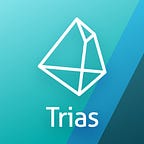the Code-based Trust Model
TL; DR
- Trust issues are not necessarily unsolved before blockchain arrives. But this technology sets up a new solution model, the code-based trust model.
- The 100% code-based trust model requires thousand times of code demonstration and validation before it is established and autonomously deployed by decentralized users.
Society runs on a bunch of trust models. Main factors include individuals, companies, organizations, and governments, explicit or unspoken rules, such as restraints, guarantees, notarizations, laws, regulations, etc., as well as the combination of these factors. Money deposit underlines the trust of banking companies; stock transactions signify trust for exchanges and legal systems backed by the state.
Code-based Trust Model
Trust issues have several solutions even before blockchain exists. But this emerging technology pioneers a new way out, the code-based trust model, an absolute mechanical trust model, where no human factor can intervene. Once codes, written by humans, are verified, this 100% trust model is all about codes, free from human factors. This pioneering practice can profoundly transform how society operates from the bottom up.
As we know, computers are ultimately controlled by people. Then how to avoid human intervention in computer operation? Blockchain adopts peer-to-peer communications with supporting mechanisms. Thousands of dispersed, decentralized computer nodes automatically supervise each other. The internal mechanism makes sure nodes cannot collude, but can be logically demonstrated, building a sophisticated anti-cheating system. Nonetheless, this technology itself does not naturally generate this result. Bitcoin and Ethereum operate on tens of thousands of nodes, with their overall security fully demonstrated. Blockchain projects running on a few nodes are, however, struggling with low security and calling for more advanced mechanisms. Blockchain projects may give rise to the 100% code trust model, but they are not sufficient conditions. Only a small number can make that happen.
This blockchain model created by humans iterates over time. As the codes run on the 100% trust model within a certain period, no intervention shall apply beyond established rules. Even a default finds no ground for redemption. The DAO Hack is a well-proven tragedy, where 10 million ETH was “stolen” (within the code rules). The whole community just stand by watching with hands tight. Long-term sustained operation of the model demands flawless codes and stringent audits before an irreversible launch. This once again testifies that this mechanism relies 100% on codes. Everything falls under the rules where no hands can stick in or press the pause button even at the time of unexpected code vulnerabilities.
The 100% trust underscores extensive decentralization of node deployment, developers, code review, testers, and users. Simply put, any string of codes must undergo rigorous demonstration and verification before their launch and deployment by decentralized users (to rid of collusion). If a blockchain project falls into the hands of a few or is centrally maintained by a certain company, then it feels more like a centralized trust. A small portion of code trust cannot build up highly secured decentralization even with the help of blockchain. This “conventional” trust model risks human intervention, data tempering, and rollback (leaving the chain abandoned).
Potential Fields of Application
When will this 100% code-based trust model give its full play? Trust models in some fields cannot be realized through codes or replaced. For instance, the food industry wins consumer trust with delicate packaging and sweeping advertising. In this case, blockchain finds no easy crack even with food traceability systems. Mixed factors (besides codes) make it hard to make a ripple.
What are some novel applications to be developed following the arrival of this new model? It leaves us much room for imagination. The creation or breakthrough of the underlying technology underpins immense impact on upper applications, which can be built on top of each other. The electronic computer made its debut in the 1940s. Its electronic circuits adopt binary number systems represented by binary bits of zeros and ones. This plain logic promotes the transition from manual calculation to automatic calculation. All computer-based applications, including VR/AR, artificial intelligence and big data analysis, operate upon simple logic operations of zeros and ones at underlying layers. Back then, we were not able to make accurate predictions for the scope of “computation”. Similarly, it is now tricky to make a guess about how far will “trust” reach? How many issues can it work out? For the time being, all predictions are just presumptions, and all impractical hypotheses just remain wild guesses.
Must Reads
Triathon series 1 | NetX series 1 | NetX series 2 | NetX series 3
NetX, the Chain-Native Internet for the Digital Living of Trustworthy and Reliable Intelligent Autonomous Systems (Trias)
Triathon | Ethanim | Tusima | Behemotum | Octavius | Leviatom |Divina
Join Coinmonks Telegram Channel and Youtube Channel learn about crypto trading and investing
Also, Read
- How to buy Bitcoin Anonymously | Bitcoin Cash Wallets
- Binance vs FTX | Best (SOL) Solana Wallets
- Binomo Review | Stoic vs 3Commas vs TradeSanta
- Capital.com Review | Crypto Lending Platforms in Hong Kong
- How to Swap Crypto on Uniswap? | A-Ads Review
- WazirX vs CoinDCX vs Bitbns | BlockFi vs CoinLoan vs Nexo
- LocalBitcoins Review | Cryptocurrency Savings Accounts
